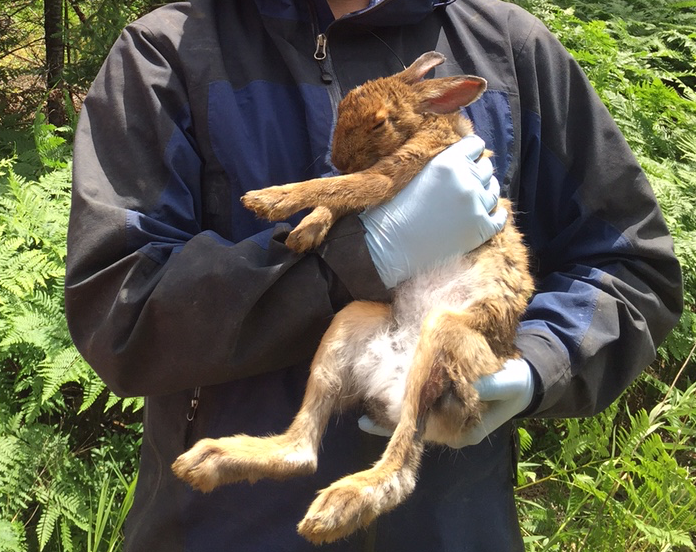Hare today, hare tomorrow
Thanks to extensive wildlife habitat management in recent years, Michigan’s snowshoe hares have been given a leg up in their fight for survival.
The Rapidian's Nonprofits section features stories written directly by local nonprofits about their work. These stories reflect their perspectives, not The Rapidian's editorial voice.
Climate change has not been kind to Michigan’s snowshoe hare.
Every year, the coats of these small mammals change with the seasons – snow-white in winter, reddish-brown in summer – to help conceal them from predators.
But for more than a decade, Michigan has seen above-average winter temperatures that have resulted in less snowfall. And when spring arrives early or winter arrives late, a hare’s natural camouflage can actually work against it.
“A white critter is a very easy target for predators if it’s December and there’s no snow on the ground,” said Brian Piccolo, a wildlife biologist with the Michigan Department of Natural Resources.
However, thanks to extensive wildlife habitat management in recent years, Michigan’s snowshoe hares have been given a leg up in their fight for survival.
Creating safe havens
While snowshoe hares are not considered threatened or endangered, the likely population decline – as suggested by a Michigan State University study, which showed a near 50 percent drop in the Lower Peninsula – has been a cause for concern.
“That suggested two things, either habitat or climate change. There has been a general northward shift in hare occurrence in Michigan’s Lower Peninsula that is likely climate-related,” said Gary Roloff, associate professor in the MSU Department of Fisheries and Wildlife.
Roloff, who conducted the study, said that on average, the Lower Peninsula only sees 60 days with snow cover, while the Upper Peninsula has about 140 days.
Snowshoe hares are an important part of the Michigan ecosystem, and when their numbers decline, it causes a ripple effect throughout the forest. Besides providing prey for the state’s foxes, owls and bobcats, the hares are instrumental in keeping forests healthy by eating the twigs and bark, which allows new trees to grow.
As it sought to engage in a targeted habitat restoration project for snowshoe hares, the DNR partnered not only with MSU but also with Michigan United Conservation Clubs, a nonprofit that works to protect Michigan’s natural resources and outdoor heritage. In this effort, biologists and volunteers have partially cut more than a thousand conifers, such as black spruce and balsam fir, to provide “horizontal cover” for the hares.
“The tree trunks are partially cut so they’ll fall over but are still attached to the stump about 3 to 4 feet off the ground. Multiple trees are typically cut and overlapped to provide areas where the snow isn’t as deep underneath and where hares can hide from predators and loaf around as they move to and from food sources,” Piccolo said.
The work is part of MUCC’s “On-the-ground” program, made possible through a DNR grant, to improve habitat for fish and wildlife. Since 2013, more than 1,600 volunteers have participated in weekend projects such as cutting trees for snowshoe hares and deer, removing invasive trees, and planting a variety of species for wildlife food and cover, said Sarah Topp, MUCC wildlife volunteer coordinator.
This habitat construction is part of the art and science of forestry, which involves hands-on maintenance that includes logging and new tree planting. Sound forestry practices keep Michigan’s forests healthy by removing the older trees and undergrowth that fuel wildfires, and they enable species like snowshoe hares to thrive.
That work is largely paid for by hunters, who were the first to report the drop in hare numbers to the DNR’s Wildlife Division.
Conservationists in Action
According to DNR records, the sale of hunting and fishing licenses generated an estimated $63.2 million last year, which represents the vast majority of the state’s wildlife management funding.
“This money is funneled directly into activities such as habitat improvements and invasive species control,” said Matt Pedigo, chair of the Michigan Wildlife Council. “Without their contributions, the work to improve wildlife habitats for species, like the snowshoe hare, would not be possible.”
It’s helping, Piccolo said.
“The hares are using it. We’ve set up trail cameras to monitor hare use of the habitat work and have seen great results. Almost all of the cuttings have hare droppings and tracks all under them within days of the work being done,” he said.
Additional studies may be conducted in future years to see if there’s a measurable increase in hare populations in these areas, but conservationists are hopeful.
“It’s my job to do what’s best for the protection and benefit of wildlife species within my work area,” Piccolo said. “And snowshoe hares really need the help.”

A core service of the Grand Rapids Community Media Center






